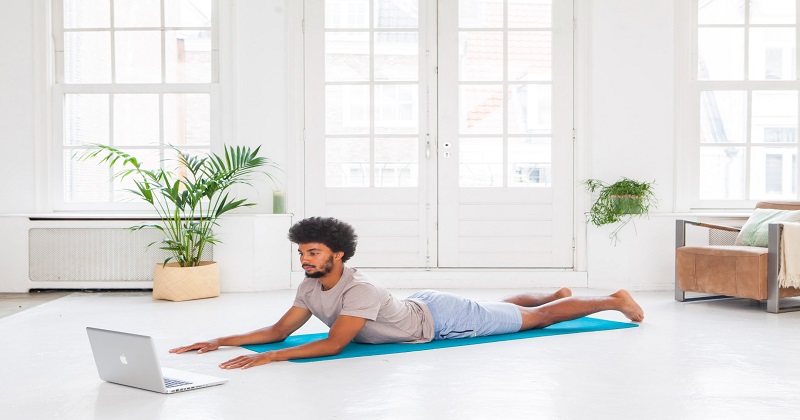
The epidemic transformed the majority of us into distant workers overnight, and many of us have remained thus. However, unless you’re a seasoned home worker, you may have found yourself switching from your big screen and ergonomic office chair to a laptop and sitting on your kitchen stool. If your home office setup isn’t optimal, you’re probably already aware of the consequences, such as tense shoulders and back aches. So we’ve compiled a list of techniques to avoid and treat aches and pains when working from home.
Set up your workspace;
Follow best practices standards for setting up your work environment as much as feasible. Try to adjust your chair and workstation height so that your forearms and wrists are parallel with the floor as you type. The top of your screen should ideally be around eye level, roughly an arm’s length away from you. Your knees should be level with or lower than your hips. Find something to rest your feet on if they don’t comfortably contact the floor.
If you operate from a laptop, consider purchasing an external keyboard and mouse. Sets are reasonably priced, and your shoulders, wrists, and eyes will thank you. Then, position your laptop atop books, yoga blocks, or anything you can find to raise the screen to eye level. Even better if you can obtain an external display.
Take breaks – get up and walk around;
Whether at work or at home, you should get up from your chair and away from your screen on a frequent basis. Set a timer for at least every hour. Use the Pomodoro technique of 25 minutes of labor and 5 minutes of rest. Get a glass of water (avoid the refrigerator!) and do one or two of the following.
Working from home yoga exercises
Upper back and shoulders;
Even if you have the perfect workstation setup, we’re all lugging around more strain than normal right now, surrounded by spouses, flatmates, kids, and the buzzing fridge on week 8000 of lockdown. The heat is particularly intense in our shoulders and upper back.
Arm Swings;
Arm swinging is a quick and easy technique to stretch your shoulders and upper back. Stand up straight, with your knees slightly bent and your arms at your sides. Raise both arms at about shoulder height, then swing them back past your hips and forward with momentum. Swing your arms rhythmically. Put a little effort on the backswing and let the front swing flow naturally. Repeat 6-10 times. When you’re done, stand for a bit with your eyes closed to feel the impacts on your body.
You will improve your posture and relieve tension in your shoulders and chest muscles by strengthening the muscles in your upper back. By releasing the diaphragm, you will be able to breathe more effortlessly.
Cobra position ;
Bring your hands level with your shoulders and your elbows close to your torso while lying on your front. If you have lower back pain, your feet might be together or slightly wider than hip-distance. Engage your core muscles and elevate your chest into Cobra posture on an in-breath. Consider this motion to be coming from the upper back muscles rather than pushing weight into your hands. Maintain a relaxed neck. Exhale and slowly lower yourself to the floor. Repeat this process two more times.
If it seems comfortable, raise your hands up with you as you elevate your chest for the following two reps to stress your upper back muscles. Alternatively, repeat regular Cobra two more times.
Upper back muscle builders;
Try this instead of lying on the floor if you prefer not to. A physiotherapist recommended this for my ‘computer shoulder.’ Standing up, place your elbows at your sides and your forearms in front of you, palms up, as if carrying a tray. Raise your shoulders to your ears, then roll them down and back, pressing your shoulder blades into your back. Keeping your elbows in place, bring your hands out to the sides, beginning with your thumbs. You should see your shoulder blades becoming closer together. The deep rhomboid muscles between the shoulder blades are activated. The rhomboids collaborate with the trapezius muscles to maintain the position of your shoulder blades and down so this exercise is also helpful if you find your shoulders hunched up by your ears.
- Spinal mobility; Reduce back pain by keeping your spine mobile with twists, side bends, backbends, and forward bends. You can do all of these easy exercises in your chair, but you should get up to do them:
- Twists; Lie on your back and pull your right knee across to your left side while looking over your right shoulder. Stay for a few breaths before switching sides. There are several twist variants, so explore to find one that works for you.
- Forward bends (flexion) and backbends (extension); Come onto all fours and perform a few rounds of Cat Cows, inhale as you elevate your chest and tailbone and lower your belly in Cow posture, then exhale as you tuck your tailbone and chin down, rounding your back in Cat stance.
- Side bends; return to a standing position, lift your arms, and grasp your right wrist with your left hand. Bend to the left, allowing your right side to extend. Then alternate sides. If you have back discomfort, more tailored lessons may help you move more easily and confidently again.

Post Your Comments